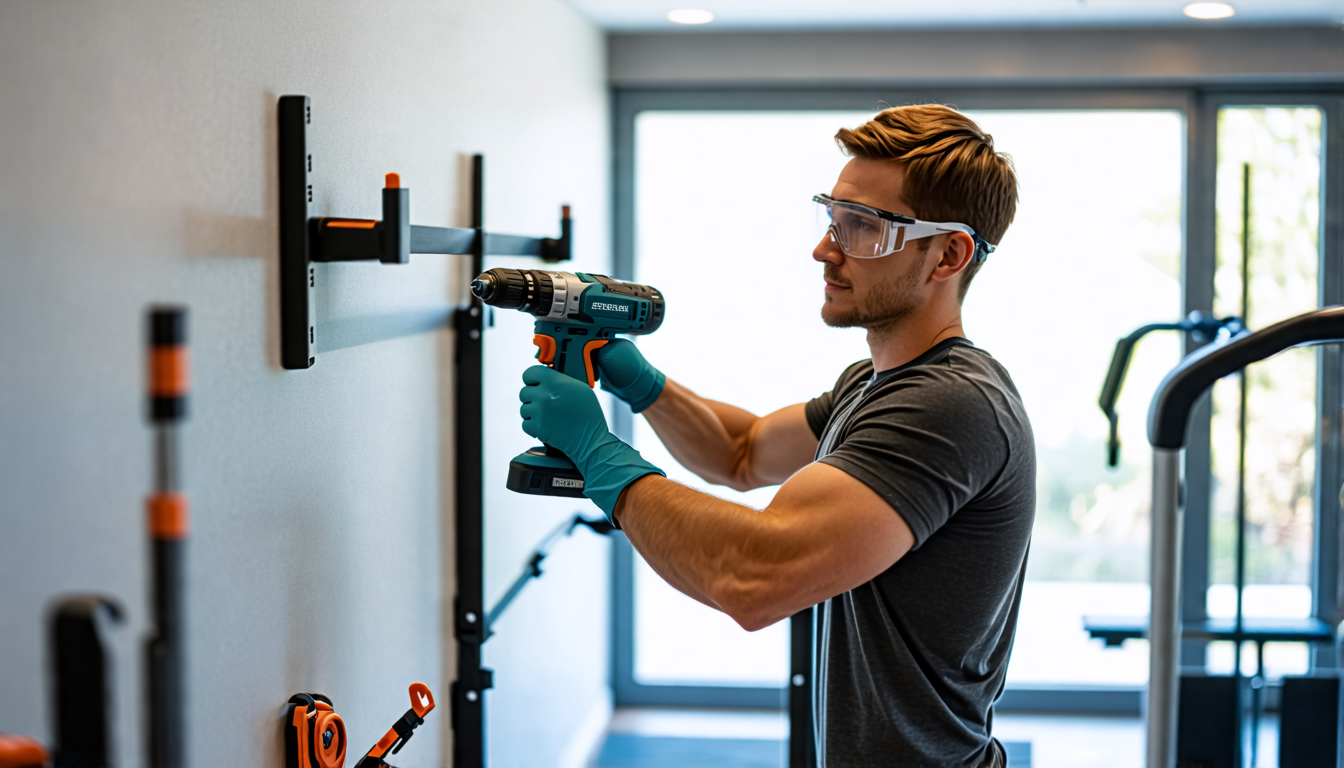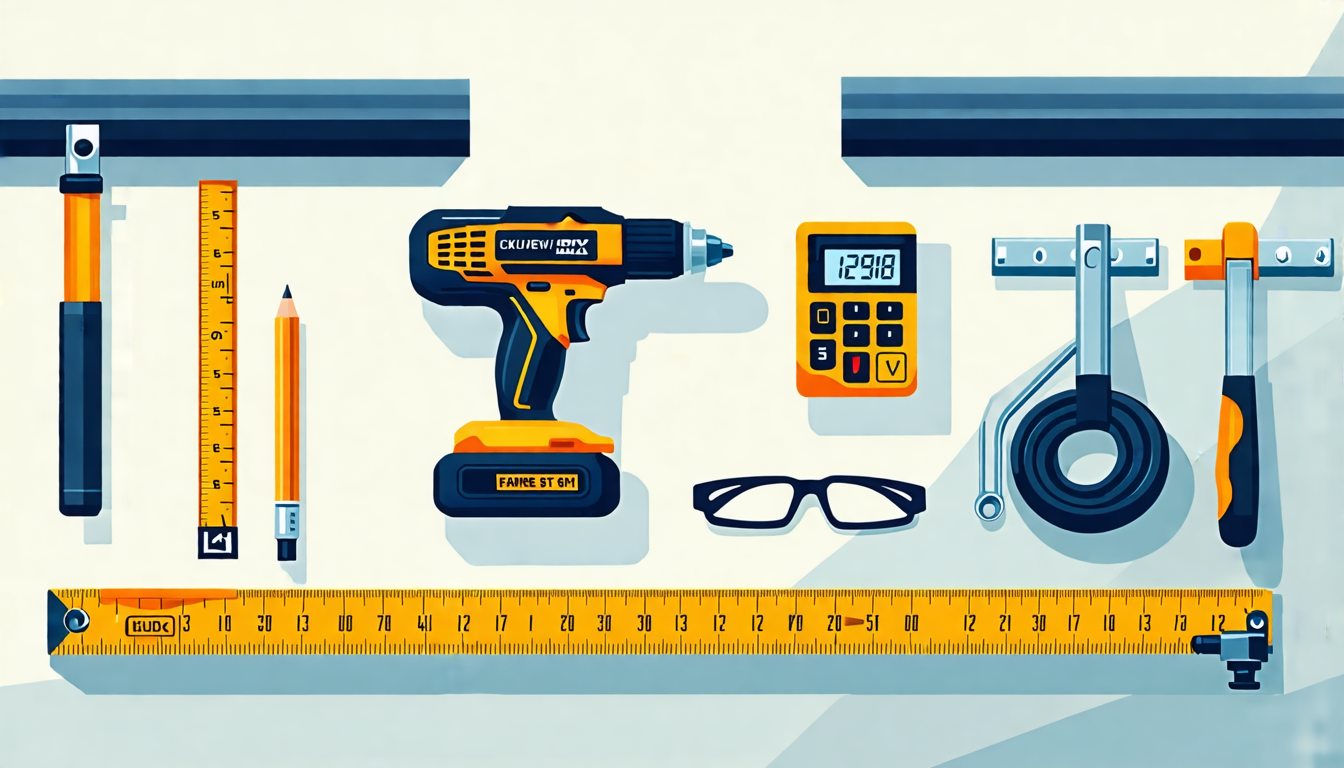Installing a wall-mounted fitness bar in your home is a great way to enhance your fitness routine without needing to invest in a bulky, standalone piece of equipment. With a wall-mounted fitness bar, you can perform a variety of exercises such as pull-ups, chin-ups, and even some core workouts, all within the comfort of your own home. However, achieving a secure and stable installation requires the right set of tools and a careful approach to ensure both functionality and safety.
In this guide, we will walk you through the essential tools needed for a successful installation of a wall-mounted fitness bar. We’ll cover everything from power tools like drills and drill bits, to precise instruments such as stud finders and levels, to basic tools like wrenches, sockets, and a tape measure. Additionally, we will highlight important safety tools and accessories you’ll need, such as safety goggles, gloves, wall anchors, pencils for marking, and a step ladder or sturdy chair for elevated work. By the end of this article, you’ll feel equipped and confident in your ability to securely install your fitness bar, making your home fitness endeavors that much more effective and enjoyable.
Essential Tools Required for Installing a Wall-Mounted Fitness Bar
Drills and Drill Bits
Investing in a good quality drill is crucial when installing a wall-mounted fitness bar. Drills help create the necessary holes in your wall, making it easier to secure the fitness bar. Depending on your wall material—whether it’s drywall, brick, or concrete—you’ll need different types of drill bits. For drywall, a standard drill bit will suffice. However, for masonry walls, you will need a masonry drill bit to efficiently bore holes. If you’re uncertain about the type to use, consulting the fitness bar’s installation manual can provide specific recommendations.
Stud Finder
A reliable stud finder is indispensable for securely installing a wall-mounted fitness bar. This tool helps locate the wooden or metal beams behind your walls, known as studs. Screwing your fitness bar directly into these studs ensures a secure hold and prevents the bar from pulling away from the wall during use, which could cause injury or damage. There are different types of stud finders available, including magnetic and electronic options. Both types can be effective, but electronic stud finders often offer more precision, which is beneficial for a safe and secure installation.
Level
A level is essential for ensuring that your fitness bar is installed perfectly horizontal. An uneven bar can make workouts more difficult and unsafe, as well as lead to undue stress on the mounting points. Traditional spirit levels are highly effective and simple to use. Digital levels can provide enhanced accuracy and ease of use if you are looking for something more modern. Regardless of the type you choose, using a level will ensure your fitness bar offers a balanced and stable exercise environment.
Wrenches and Sockets
Wrenches and sockets are crucial for tightening bolts and nuts securely during installation. Depending on the design of your fitness bar, you might receive hex bolts, lag bolts, or other fastening mechanisms that require particular sizes of wrenches or sockets. Having a set of adjustable wrenches or a complete socket kit can ensure you have the necessary tools on hand. Properly tightened bolts and nuts are crucial for the overall safety and durability of your wall-mounted fitness bar, making wrenches and sockets non-negotiable tools for this task.
Tape Measure
One of the first steps in installing a wall-mounted fitness bar is accurately measuring the space to ensure it fits properly. A tape measure aids in measuring the height from the floor to where the bar will be mounted, the distance from nearby corners or walls, and the alignment with studs. Proper measurements ensure that the bar will fit in the desired location and that all anchor points will be correctly positioned. Accurate measurements contribute to both the usability and aesthetics of your home fitness setup.
Having these essential tools in your toolkit will streamline the installation process, ensuring your wall-mounted fitness bar is securely and accurately placed. In the next sections, we’ll discuss the safety tools and accessories that further enhance the installation process and maintain the integrity of your home fitness bar.

2. **Safety Tools and Accessories for Installing a Wall-Mounted Fitness Bar**
Safety Goggles and Gloves
When installing a wall-mounted fitness bar, safety should be your top priority. Safety goggles and gloves are essential tools to protect yourself from potential hazards. Safety goggles shield your eyes from dust, debris, and any unexpected particles that might fly towards you while drilling or hammering. Gloves protect your hands from sharp tools, rough surfaces, and potential splinters. A good pair of work gloves will provide both protection and a better grip on your tools, ensuring that you have full control while working. Never underestimate the importance of these basic safety tools when setting up your home fitness bar.
Step Ladder or Sturdy Chair
To ensure a safe and efficient installation process, a step ladder or a sturdy chair is necessary to reach the height where you plan to mount your fitness bar. A step ladder is preferable because it offers more stability and adjustable heights. Make sure the ladder you use is in good condition and placed on a flat, even surface. If you’re using a chair, it should be strong enough to support your weight without wobbling. Having a stable platform to stand on will help you maintain balance and accuracy while drilling or marking holes, making the installation of your wall-mounted fitness bar both safer and more precise.
Wall Anchors
Wall anchors are indispensable for securely mounting your fitness bar, especially if the studs in the wall do not align perfectly with the mounting brackets. Wall anchors offer additional support and distribute the weight of the fitness bar across a broader area, preventing it from pulling out of the wall. There are various types of wall anchors, including toggle bolts, molly bolts, and plastic expansion anchors. Choose the right type based on the wall material and the weight capacity of the fitness bar. Properly installed wall anchors ensure that the fitness bar is securely fastened and safe to use, providing you with a reliable solution for your home fitness routine.
Pencil for Marking
A pencil is a simple yet crucial tool for marking the spots where you will drill holes for your fitness bar. Accurate markings with a pencil ensure that the holes are drilled in the correct locations, aligning perfectly with the mounting brackets. Make sure to use a sharp pencil to get fine, precise marks. Double-check your measurements before drilling to avoid mistakes that could lead to an unstable installation. Having clearly defined marks will make the installation process more straightforward and ensure that your wall-mounted fitness bar is correctly positioned.
Instruction Manual and Safety Guidelines
The instruction manual and safety guidelines provided by the manufacturer are essential resources for installing your wall-mounted fitness bar correctly and safely. These documents contain specific instructions on the installation process, including the types of tools required, step-by-step procedures, and important safety precautions. Following the manufacturer’s guidelines ensures that the fitness bar is installed according to their specifications, minimizing the risk of improper setup or accidents. Additionally, these manuals often include troubleshooting tips and maintenance advice to keep your fitness bar in optimal condition. Always refer to the instruction manual before starting the installation process to ensure a safe and successful setup.
Incorporating these safety tools and accessories into your installation process is crucial for a successful and secure setup of your wall-mounted fitness bar. Taking the time to prepare and use the right safety measures will provide peace of mind and a solid foundation for your home fitness workouts.
In conclusion, installing a wall-mounted fitness bar at home is not an overly complex task, but it requires a well-thought-out approach and the right set of tools to ensure safety and functionality. Essential tools such as drills and drill bits, a stud finder, a level, wrenches and sockets, and a tape measure form the backbone of your installation process. These tools help in accurately positioning and securely fastening the fitness bar to the wall, ensuring it can support your weight effectively during workouts.
Additionally, incorporating safety tools and accessories like safety goggles, gloves, a step ladder or sturdy chair, and wall anchors are critical for a secure and risk-free installation. The use of a pencil for marking drilling points and adhering closely to the instruction manual and safety guidelines provided with the fitness bar ensures that the installation process proceeds smoothly and correctly.
By carefully assembling these tools and following safety practices, you can confidently set up your wall-mounted fitness bar, turning a simple home wall into your personal fitness station. This setup will not only enhance your workout routine by providing a versatile platform for various exercises but also save space and allow you the convenience of exercising at home. Ultimately, the successful installation of a wall-mounted fitness bar signifies a step towards achieving your home fitness goals safely and effectively.

